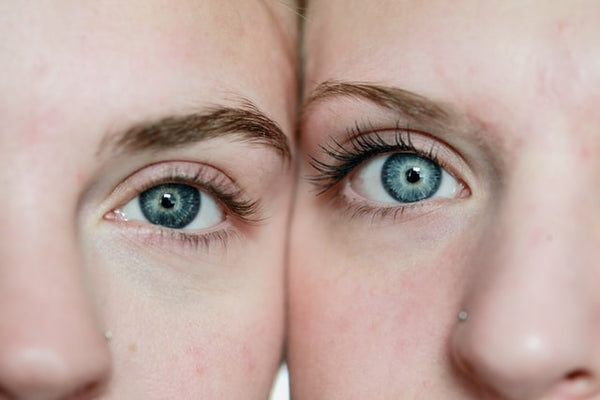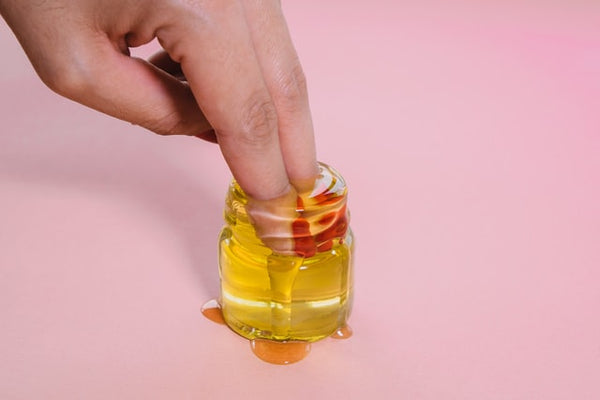Dry Skin vs. Dehydrated Skin what's the difference?
Did you know there’s a difference between dry skin and dehydrated skin? While it sounds the same, there’s a huge disparity between the two: Dry skin is a skin type, dehydrated skin is the condition of your skin on the day. To understand this seemingly confusing definition, we spoke to skin expert Hanna Södergren to gain some insight. Hanna is a beauty therapist and all-round skincare guru, having worked with some of the world's best luxury spa brands.
So Hanna, how is dry skin different from dehydrated skin?
To make it clear from the start dry skin and dehydrated skin are two different things. We all have a skin type such as oily, dry and combined. This is basically how our skin functions depending on the production of sebum (our natural oil production).
However, our skin is also affected by our everyday habits and environment including:
- Face washing
- Hygiene
- Diet choices
- The climate and environment that surrounds
All these things can create a skin condition. Examples of skin conditions include sensitivity, dehydration, breakouts and even sunburn to name a few.
Basically, Hanna says, the difference between a skin type and skin condition is that we can't change our skin type but we can change a skin condition.
Medical skin experts agree too. Ross C. Radusky, a board-certified dermatologist at SoHo Skin & Laser Dermatology said: “Dry skin is characterised by fewer oil-producing glands on the face and body. Dehydrated skin, on the other hand, is a lack of water, not oil. So you can actually have an oily complexion but still have dehydrated skin.”

Dry Skin vs. Dehydrated skin
Dehydrated skin on your face
So we know dehydration is caused by external factors like weather, diet and caffeine consumption which can diminish the water content of your skin. But it looks and feels different to dry skin too. It:
- Feels tight
- Looks dull in the mirror
- Your fine lines may look more exaggerated, or you’ll notice them in places you don’t remember having them.
- Your dark under-eye circles will be more pronounced
- Congestion (breakouts) irritation and inflammation are common signs
Dry skin on your face
Dry skin is a skin condition where the skin lacks oil because it produces less sebum. This lack of sebum means the skin has fewer lipids to help it retain moisture and protect against external aggressors. Dry skin:
- Can feel uncomfortable
- Is often around the eyebrows and the corners of the nose and mouth
- Is more likely to be larger flakes of skin fall when you scratch (rather than a look of ‘snow falling’)

How does dehydrated skin cause breakouts?
If you have dehydrated skin it's easier for the dead, dry skin cells to pile up and block our pores from breathing properly. When the natural sebum tries to push through to condition our skin as it usually would, it gets stuck due to dead skin cells. When the oil builds up inside the follicle, eventually it will create breakouts. Learn more about how a build-up of sebum causes breakouts here.
Winter means dehydrated skin for most of us
Harsh heating, sudden temperature changes, dry wind and even high-necked collars in winter combine to change our skin condition, making it dehydrated.
Bettina Tyrell, Instyle Beauty Editor, That Beauty Podcast host and all-round beauty expert explains it: “Most of us experience dehydrated skin in winter because the air is dryer (naturally and from heating etc). The air looks to our skin for moisture and draws it out leaving us parched.”
This parched feeling not only makes us look older, but it also feels awful to touch, and can lead to sensitivity and irritation. Luckily though, skin expert Hanna Södergren says there are answers, but you have to start by addressing the skin condition first:
Any skin type can be mixed with any skin condition. To help the skin you must focus on the current skin condition. If you have a bad sunburn you will put aloe vera and soothing products on no matter what your skin type is like. The same thing goes for dehydration. It must be a priority to work on before you can focus on the actual skin type.

Skin Expert Hanna Södergren’s Beauty Hacks: How to treat dehydrated skin on your face
-
Drink water. And lots of it.
There is a difference between drinking water and using it on our skin. When you use water on the skin it is actually dehydrating, only washing the face with water makes dehydration worse (use a cleansing oil in this case) However, it is extremely important to drink water so it can help our skin cells stay healthy. Drinking water will help dehydration, only using water on the skin won't.
-
Exfoliate dehydrated skin
This is an extremely important step. If you do not exfoliate the dead skin cells will build up and not only cause breakouts but will also block the full potential of the product absorption. To have a good exfoliator at home is a must for healthy-looking skin. Exfoliate all the dull dehydrated skin off and allow your face to breathe. Make sure to hydrate properly afterwards.
-
Use serums to rehydrate your skin
Serums are my favourite step of the skincare routine. They’re a very concentrated product that pushes through and helps the skin from within. They will work on your skin’s dehydration from the inside. Our very own hydration in the skin comes partly from hyaluronic acid. If you are lacking hydration try to use a serum that contains hyaluronic acid. This will plump the cells.
-
Change up your skincare routine
We all have our favourite products that we love and use every day. We buy them, use them and buy them again. Over and over. How often do you actually change up your products?
Our skin is extremely affected by the environment, the seasons and the temperature. Just because a moisturiser worked wonders during summer does not mean it will work as well during winter. Our skin is constantly changing and we need to acknowledge when these changes are happening. When you have 10 minutes to spare take a look at your bare skin in the mirror. Look closely, what do you see? How is your skin reacting if you pinch or stretch it? Depending on how your skin looks and feels try to think of what products you might need or why it is looking the way it is.
Skin Expert Hanna Södergren’s Beauty Hacks: How to treat dry skin
Having dry skin can feel like a pain but it doesn't have to be if you treat it right. It’s your skin type, so let’s work with it!
If you’re managing dry skin, the main thing I’d say is to invest in your skincare. Investing in skincare means investing in your health, your aging and your confidence. Allow yourself to invest in a proper skincare routine.
-
Hydrate dry skin in all forms
Since we know dry skin means your skin naturally produces less oil, exfoliate then hydrate with face oil and try a thicker moisturiser for daytime. This creates a seal that stops water from escaping the skin. Drink plenty of water and avoid harsh and drying products.
-
Deep nourishment is vital for dry skin
Our skin repairs itself and works really hard on cell renewal at night when we are sleeping. This gives you the perfect opportunity to give your skin a bit extra to work with. If you haven't already got a serum, invest in one! They are naturally more potent and have more nourishing ingredients.
I also recommend using a nourishing, hydrating sleeping mask 2-3 times a week. This will give your skin deeper nourishment and you will wake up with a more plump, glowy skin.
-
Be aware of the fabrics you are wearing and sleeping on
Swap your cotton pillowcase for one made of silk or satin. Cotton is very drying for the skin and can be irritating. It literally pulls the moisture from your face. Having a silk pillowcase will help your skin to retain moisture and keep the face healthy. It is also better for your hair. It's a win win!
Dry skin and dehydrated skin are two very different things. Whether you’re born with dry skin or your skin is currently just dehydrated, Hanna’s tips can create real change for your skin now.
If you’re not sure which type of skin you have, try our skin quiz now!





